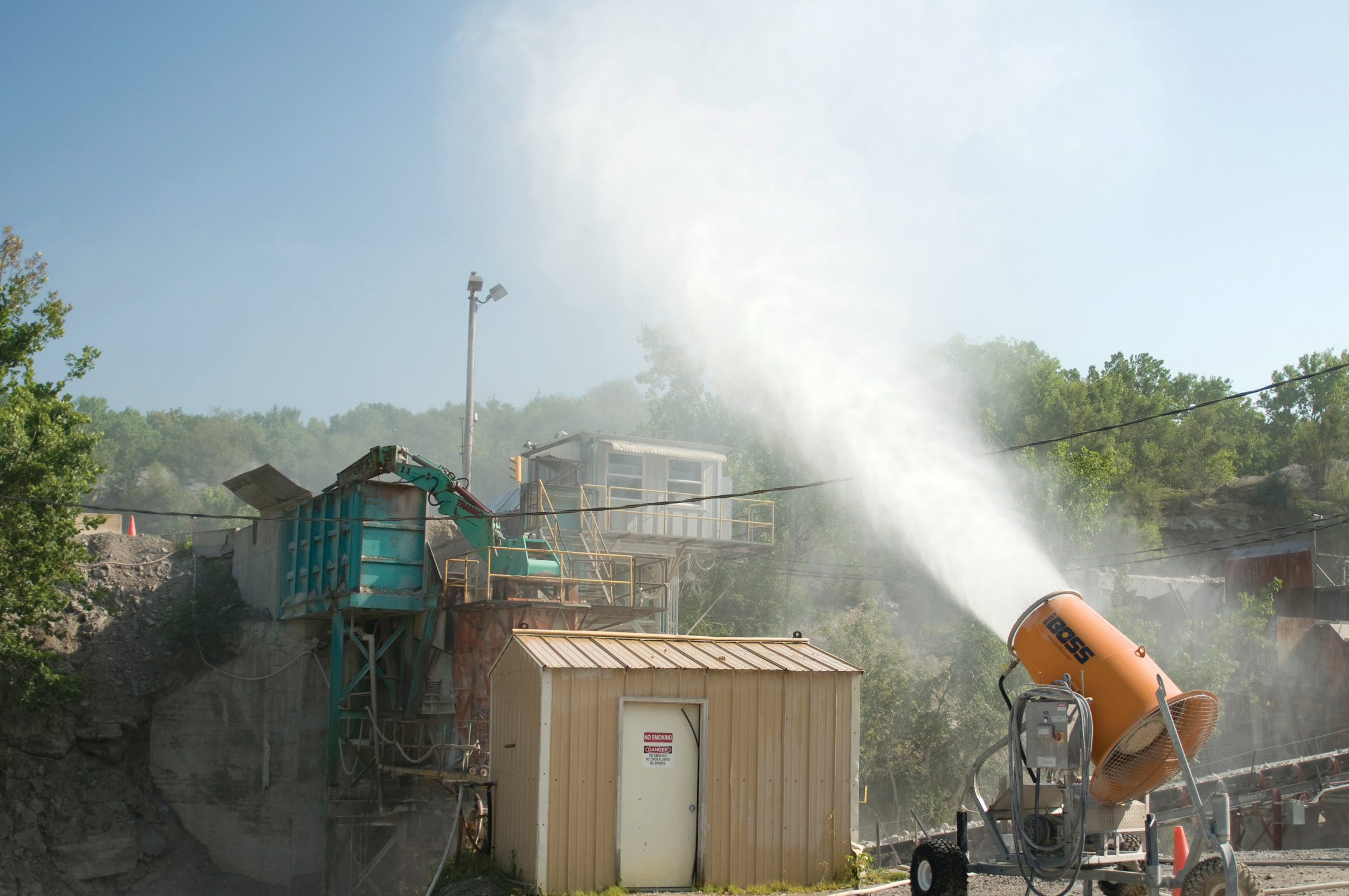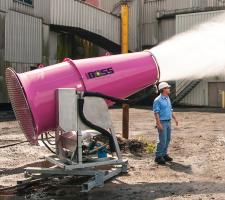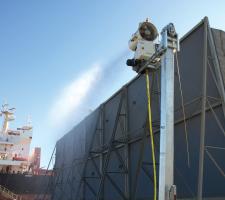
Dust emissions can be an issue at aggregate quarries but equipment can control the problem as Patrick Smith reports
By far the most important aspect of air quality in relation to quarries is the generation of dust. The SustainableAggregates information gateway says there may be small amounts of fumes or smoke generated from diesel equipment or processing plant which can cause a visual impact, but recent air quality controls have reduced these considerably.
“There may also be some gases such as NO2 and CO produced in the blasting process...,” says the organisation.
“Dust generation is unfortunately an inevitable consequence of mineral extraction due to the processes of breaking and handling rock and soils. This would not be a problem if it stayed where it was created, but it often gets taken up into the air and transported around and outside the site.
“Nuisance dust (sometimes referred to as deposited or fugitive dust) gives rise to the greatest number of complaints to quarries from local residents, and fears are commonly expressed in relation to the alleged health effects. Without appropriate mitigation, residents can potentially be affected by dust up to 1km from the source, although concerns about dust are most likely to be experienced near to dust sources, generally within 100 metres depending on site characteristics.”
This has led to a rise in the number of companies offering innovative equipment for the monitoring and suppression of dust in quarries.
Dust emissions can be an issue at aggregate extraction, processing and construction sites the world over, agrees
“Dust is defined as particulate matter up to 75µm (micron) diameter and can be considered in terms of public (environmental) health; personal (workplace) health, and nuisance (annoyance or loss of amenity).
“There are clear guidelines and standards for public and personal health dust but ‘nuisance’ dust is much harder to define. It can be described as visible dust: dust we can perceive but which isn’t necessarily harmful. It occurs as a short-term (acute) problem like a dust cloud across a road, or a long-term (chronic) problem such as soiling of glossy surfaces and windows.”
However, ‘nuisance’ dust is often associated with complaints from the public and typically forms the majority of dust arising from aggregate sites.
“However, just because a site is dusty it doesn’t necessarily mean it’s the only source of dust in a locality. In many cases dust emissions are just as likely to occur from agriculture, road transport and other sources nearby, to name a few,” says DustScan.
“When reporting dust levels at a site boundary it is very important to know if it is really your dust.”
The company highlights a range of methods to monitor and assess ‘nuisance’ or visible dust. Typically, these involve passive (unpowered) equipment to collect samples over days or weeks.
In the absence of official standards, a number of ‘custom and practice’ criteria for visible dust have become established in the UK (Institute of Air Quality Management 2012: Guidance on the Assessment of the Impacts of Construction on Air Quality and the Determination of their Significance).
These criteria relate to either the mass of dust or its visual impact (or soiling).
DustScan says its dust monitoring equipment is easy to install and operate and no specialist sample handling is required. The samplers use specially-made adhesive sticky pads to capture dust in flux and in deposition so that the pathways of dust dispersion and the effect of dust deposition can be monitored.
“The soiling effect of dust on the sticky pads is measured using software and reported in relation to visual impact criteria. As well as its suitability for assessing a site’s dust emissions towards potential receptors (nearby homes) it can also be used to assess dust propagation from other operations (for example farmland and industry) which may affect the same potential receptors,” says DustScan.
“Not only does this method of monitoring help in the improvement of on-site dust management schemes it may also help distribute the regulatory burden of monitoring dust emissions proportionately, and away from any one site in a locality.”
Dust Control Technology (DCT), a US company with a global reach, which unveiled a new dust suppressor at the recent MINExpo, points to one of America’s largest limestone mining operations as an example of successful dust suppression.
DCT says the operation has drastically reduced process downtime with a high-powered dust suppression system “so efficient that a plant spokesman estimated it paid for itself during the first month of use.”
By avoiding forced shut-downs due to high dust readings that had plagued the site, the portable equipment is said to have saved thousands of dollars in lost production, while allowing reassignment of manpower previously spent handling water hoses.
“Like many mining and quarrying operations, Linwood Mining had been using hoses and truck-mounted spray bars to help control dust at the crusher and transfer points, but results were always marginal.
“Despite their best efforts, crews could not prevent dust from becoming airborne, and every work stoppage caused by high particulate levels was costing the firm significant amounts of money,” says DCT.
An electronic monitor constantly samples air quality in the limestone mining area, and data is forwarded to Linwood’s control room and to the state of Iowa Department of Natural Resources.
To comply with rigid government standards, total dust emissions from Linwood’s plant, which produces up to 1.8 million tonnes of limestone products each year, and other production facilities in the surrounding area must remain within a specified range. Any time department air monitor readings exceed pre-set limits, a shut-down is mandatory until the 24-hour averages return to acceptable levels.
Linwood officials visiting the
“Capable of covering nearly 1.16 hectares when equipped with optional 359º oscillation, the DB-60 looked like a promising solution, and Linwood decided to rent one on a trial basis [it has since bought it],” says DCT.
The unit was situated to cover the immediate area around the primary impact crusher, a Universal 4650 that reduces the freshly-mined stone to 127mm minus.
“What had been a primary source of airborne dust quickly cleared up, eliminating the periodic work stoppages on all but the windiest days, and Linwood officials saw production levels rise.
Since implementing the control system, the facility has drastically reduced shut-downs as a result of dust emissions, a welcome change from the multiple incidents each month that were typical before the DB-60 came on board.”
According to staff, apart from the reduction in airborne particles and reduced labour costs, the DustBoss has eliminated oversaturation of material, and there has been a noticeable improvement in product quality from eliminating the over-watering common to hand-held dust control efforts.
At the recent MINExpo event in Las Vegas, USA, the company launched its new and largest design, the DustBoss DB-100, engineered to deliver the power to reach the working face of an open cast mine or large quarry.
“The suppressor has a range of more than 100m, giving it ample reach to cover material stockpiles 61m-91.4m high.
The atomised misting unit is nearly 3m tall, and can cover an area of over 26,000m² from a single location (that’s almost six football fields),” says DCT.
Meanwhile, Italian manufacturer
EmiControls, which became independent last year, says it is developing mobile and stationary solutions for optimum dust emission control in demolition work; recycling plants; in quarries and in industrial applications.
“We also carry out research and development work in the field of dust abatement, and recently unveiled the compact and fully automatic V7 dust-laying sprayer,” says EmiControls.
“To complement the V7 range we also have the bigger V12 dust controller.”
Both are equipped with special nozzles with ceramic inserts which produce a jet of finely atomised water.
“Able to reduce effectively dust particles at the source, these nozzles are mounted on a centrally located head.”
The latest valve technology and an optional second nozzle ring offer efficient water flow.
“The high-performance fan with a 52° angle of inclination and a 360° rotation angle ensures a maximum operating range, and by adding the water to the centre of the air jet the mist can be precisely targeted at the dust sources and the water consumption is reduced by up to 80%,” claims EmiControls.
A range of nozzles with ceramic inserts is available to be tailored to each specific application and various types of dust and the units use variable water consumption in the range from 18-118litres/minute with the built-in 4kW pump requiring a very low inlet pressure of 1.5bars.











